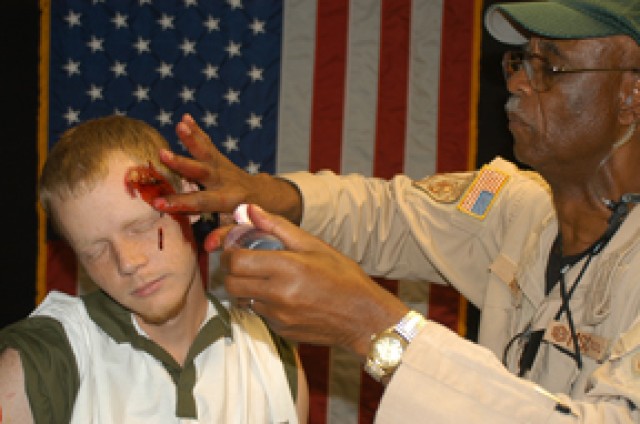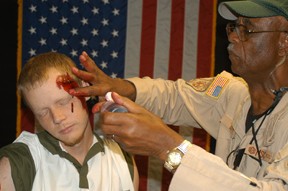FORT POLK, La. -- Imagine leaving the protective confines of a forward operating base to investigate the nearby detonation of an improvised explosive device. Upon discovering a mangled, smoking vehicle, it becomes apparent that there are injured civilians - blood is everywhere. Their screams are the worst part - it's time to think fast: Secure the area and provide aid to the casualties.
Prior to deployment, units from throughout the Army (and those from other government and military service branches) participate in a rotation, a series of immersive training exercises conducted at the JRTC over the course of several days or weeks.
JRTC offers realistic, scenario-based training that can include roleplayers, pyrotechnics, close air support, permanently-placed mock villages and homesteads, medical evacuations and more. Lanes are set up for live fires, situational exercises, convoy operations and any other scenarios as requested by the rotational unit.
It is not uncommon for rotational training unit Soldiers to come unhinged momentarily, surprised at the realism and gore that JRTC rotations offer. Much of that realism is provided by Cubic Applications, the contractor for roleplay operations at JRTC.
The contract covers a multitude of functions. The immersive nature of a rotation at JRTC owes much to the creative and prolific energy of the personnel at Cubic. In addition to the robust cadre of roleplayers, Cubic operates carpentry, sign, embroidery, fabric, printing and supply shops, and a motor pool to support the roleplay effort.
Creativity is in the air at the Cubic compound on North Fort Polk, and it was readily apparent in the briefing room June 28 where roleplay shift leaders applied moulage (MOO-lawj), makeup for simulating wounds, in preparation for a mass-casualty event to test the skills of a rotational training unit.
Fake blood was running down faces and limbs and the roleplayers' smiles seem incongruous. "I started out as a roleplayer and I loved wearing moulage because it got a reaction from the Soldiers," said Sandi Thrasher, a shift leader who was creating victims. "I'm here to help them recognize situations that will keep them alive when they deploy and build their cultural awareness."
The shift leaders' moulage techniques are based on those used in Hollywood special effects, and Thrasher has a knack for creating realistic wounds. "I learned this on the job," she said. "I use my imagination."
"When we're out there we have to give the Soldiers a taste of what they'll see when they deploy," said Michael Molina, a roleplayer with a newly applied head wound that looked fatal.
Molina has been roleplaying for a year and said moulage is one of his favorite parts of roleplaying. "It's fun to go out there and get fake blood all over the place. The Soldiers really react to it," he said. "I get satisfaction from being able to contribute to the military and I like knowing that I'm helping save lives. There are creative people out here. I've seen scenarios where the Soldiers reported a real-world gunshot wound because the makeup was so good. They didn't know it was fake."
"I have seen a few Soldiers faint, some have vomited, some cry and back away from the situation to regain composure," Thrasher said. "They have a chance to recover here - over there, they don't. We're all about preparing them for that."
The briefing room is another clue that inventiveness is plentiful at roleplay. The room is set up like a science fair, with wall-to-wall displays of roleplay products: Dummy weapons, passports, currency, school books, license plates, mannequins wearing replica clothing from Iraq and Afghanistan, moulage props and endless photos of roleplayers in action. These items help JRTC replicate the environments Soldiers will encounter when they deploy.
"We try to make everything as close to what it looks like in country as possible," said T.D. Holcomb, roleplay branch chief. "We've had several Soldiers come back through JRTC after rotating through here and deploying and they talk about how good the training was." Cubic also gets feedback through the Center for Army Lessons Learned and Operations Group about trends on the battlefield.
"We started replicating female suicide bombers because of feedback from downrange," Holcomb said. "Anything that happens in country today, we can replicate tomorrow - anything Ops Group and the trainer/mentors want we can make happen." JRTC trainer/mentors are veteran Soldiers who shadow RTU leaders and oversee the rotation training events.
B.J. Wilson is the sign shop lead, who said he enjoys creating new props and working with the other shops. "We have some talented people in the different cells," he said. If a scenario involves a generic company or world aid organization, Wilson has to design a logo and produce signs for their vehicles. "When I finish a design, I pass it to the embroidery shop, where they make caps and patches, while I make signs and vehicle magnets," he said. The sign shop also makes the road signs for the training area and uses vinyl, metal, magnets and screen printing to make the illusion of Iraq or Afghanistan complete. "The only thing we don't work on is paper," Wilson said.
The Cubic production process is down to a science, and it's all about efficiency. "Our embroidery and sewing shops make all of our garb," Holcomb said. Some of the clothes and accessories are made from scraps or refitted from other items. The fabric shop created prayer mats from old mattress pads, and even fashioned suicide-bomber vests from scratch. "We don't throw anything away," Holcomb remarked. "This is cost-saving for the government. It's more cost and time effective to make things ourselves." The shops make quick work of creating the props necessary for a rotation scenario. "We can change 'the box' (the nickname for the JRTC training area) from Iraq to Afghanistan in three days. It probably takes more time to design new scenarios than it does for us to make the props."
Jeff Easterling, a Cubic scenario integrator, works with Ops Groups and its task force representatives to build scenarios and serves as a liaison. "We get our information first-hand from Ops Groups, and scenario creation is a functional process," he said. "I love what we do here. We might turn an old laptop into a simulated spectrum analyzer, or use a CB radio as a Taliban radio station."
The motivation for the Cubic employees often stems from personal attachment to the military. "Most of the people here have family in the military," Easterling said. "They take their jobs to heart, and that's where their motivation comes from: The heart. These folks around here care about what they're doing."
Thrasher, who has worked in the roleplay division for six years, echoed Easterling. "It's one of the most rewarding jobs that I've ever held, and I left a good job to come here," she said. "My husband is retired and my children are in the military. Soldiers deserve any help a civilian can give them."
Editor's note: This is the fourth in a series of stories about the Joint Readiness Training Center at Fort Polk. This series explores the people and organizations behind the scenes of a unit rotation at the center. The first stories explored the roleplayers, firemarkers and opposing forces. Watch for more stories in this ongoing series in future issues of the "Guardian."<i/>




Social Sharing